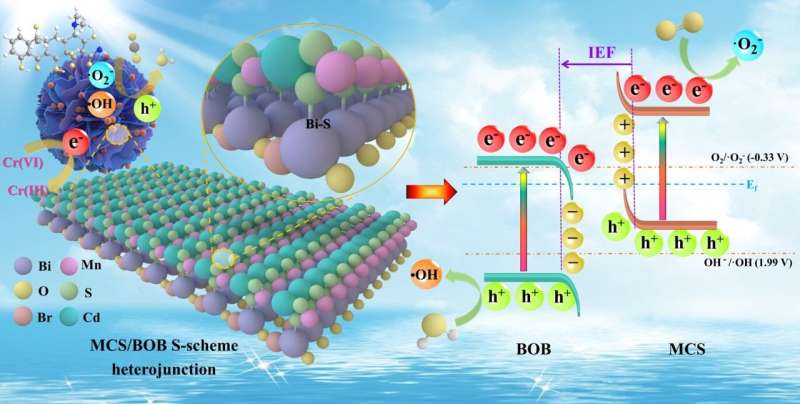This article has been reviewed according to Science X's editorial process and policies. Editors have highlighted the following attributes while ensuring the content's credibility:
fact-checked
proofread
A chemically bonded photocatalyst with rich oxygen vacancies for improved photocatalytic decontamination

A challenge in promoting the industrial application of photocatalysis technology for environment remediation lies in the design of high-performance photocatalysts. These photocatalysts should be endowed with efficient photo-carrier separation and intense redox potentials to boost photocatalytic pollutant removal.
In a study published in Advanced Powder Materials, a group of researchers from Zhejiang Ocean University and University of Missouri revealed the modulation of interfacial chemical bond of Mn0.5Cd0.5S/BiOBr assisted by with rich oxygen vacancies. This, in turn, elucidated the underlying mechanism for boosted photocatalytic performance.
"BiOBr is a visible-light active photocatalyst with several advantages, including a favorable band configuration, exceptional photo-oxidative capacity, distinctive 2D architecture, ecological compatibility, abundant resources and robust durability," explained Shijie Li, co-lead author of the study. "However, constrained absorption of visible light and sluggish photo-carrier diffusion and segregation hamper its practical application."
The team developed an S-scheme photosystem of Mn0.5Cd0.5S/BiOBr with interfacial bond and oxygen defects, constructed by pinning Mn0.5Cd0.5S nanoparticles on BOB microflowers. This was devised for efficacious decontamination of antibiotics and Cr(VI).
"Physical contact without chemically bonding hetero-interface between the two components, which is insufficiently interactive, generally results in an unsatisfactory charge migration passage," added Bin Zhang, co-lead and co-corresponding author.
"Besides, defect engineering is another effective strategy to upgrade the catalytic property. Thus, precise construction of chemically bonded S-scheme heterojunction with structural defects is essential for efficient photocatalytic water purification but is rarely exploited in photocatalytic applications."
The team's findings provide a feasible approach to developing outstanding catalysts for environmental protection via combining interfacial chemical bonds and defects modulated S-scheme junction.
More information: Shijie Li et al, Chemically bonded Mn0.5Cd0.5S/BiOBr S-scheme photocatalyst with rich oxygen vacancies for improved photocatalytic decontamination performance, Advanced Powder Materials (2024). DOI: 10.1016/j.apmate.2024.100183
Provided by KeAi Communications Co., Ltd.




















